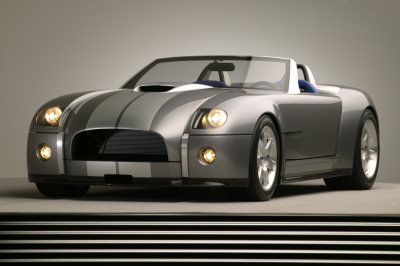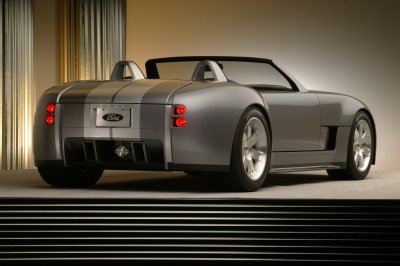


|
9th January, 2004 The Ford Shelby Cobra concept, like the legendary 1960s original, features a utilitarian body tightly wrapped around a race-bred engine and chassis. Every surface and line has its roots in the car’s uncompromised performance. "We let the powertrain, the space frame and the suspension dictate the architecture for the body," said Richard Hutting, chief designer. "The result was a very authentic, modern and desirable shape that does justice to the original Shelby Cobra, but doesn’t share a single dimension or proportion with it." Through key design details – the dominant grille opening, vertical bumper bars, stacked lamps front and rear, side air extractors and, most importantly, the powerful bulge over each rear wheel – the historical connection to Shelby’s original model is undeniable. Surprising Package While Ford Design is known for its modern interpretations of legendary vehicles – the Ford GT, Mustang and Thunderbird, to name just a few – it also leads the industry in innovative ways to carry people and cargo. From the Model A to the first Mustang, to the world’s most versatile sport utility vehicles, Ford has a history of packaging efficiency, and the Ford Shelby Cobra concept is no exception. A key engineering decision – to mount the concept’s six-speed manual transmission at the rear of the car – enabled designers to give the car almost 3 inches more legroom than similar competitors’ performance vehicles, while providing nearly perfect weight distribution. "From a package perspective, the rear-mounted transmission and the small-diameter, twin-plate clutch made for a larger foot space than typically possible in such a small car with a large engine. This 10-cylinder, 605-horsepower, all-out sports car has more legroom than in a Ford Crown Victoria sedan," Hutting said. "We also didn’t have to compromise the driving position by offsetting the pedals – an important consideration in a performance car." Long Wheelbase, Short Overall Length Performance elements help to define the exterior, as well. Because the engine sits rearward of the front wheels, the front overhang is extraordinarily short. An equally brief rear overhang gives the Cobra concept a 100-inch wheelbase – longer than that of a Dodge Viper, but with a head-to-tail measurement that is more than 20 inches shorter. In fact, the front and rear overhangs are both shorter than on the 1965 Shelby Cobra – the rear considerably so. These proportions place the Ford Shelby Cobra concept into a league of its own among production-feasible vehicles, communicating rear-drive power and serious performance. The car's stance on the road is unmistakably purposeful, with only 4.5 inches of clearance between the carbon-fibre chin spoiler and the pavement. From the rear, powerfully bulging wheel arches embrace the massive 19-inch rear wheels, signifying that that’s where the power comes to the ground. Clean, Unadorned Surface Language Just as designers used the mechanical package to drive the Ford Shelby Cobra concept’s proportions and attitude, they drew from the car’s racing persona to create a clean, unembellished "wrapper" for the powertrain and chassis. The front section of the body is a forward-tilting "clamshell." This simple design provides immediate, wide-open access to the powertrain and front suspension while defining the clean hood profile. Prominent design elements include the oversized grille opening for the radiator and the chin scoop below it for the oil cooler. The headlamps and driving lamps at the front of the car are stacked vertically, as on the original Shelby Cobra. "These lamps, combined with the vertical billet-aluminium bumper bars, the grille opening and the muscular fenders, are the way the front of the concept communicates ‘Cobra,’ " Hutting said. In character with the Ford Shelby Cobra concept’s uncompromised performance, there are no windshield wipers, no side windows and no convertible top – it is a fair-weather-only racing machine. The sides of the body are pure function. Just aft of each front wheel is a prominent rectangular air extractor – to cool the engine and the brakes – and a conventional forward-swinging door with a dramatically simple shut line that terminates at the rear fender. To emphasise the clean body sides, designers also omitted door handles. The decision to forgo exterior door handles left the team with a quandary: How do you open the doors? They briefly looked at incorporating an electronic button but settled on the original, elegantly simple Cobra solution of placing the inside handle up high, where it can easily be reached from outside the car. "It’s a race car," Hutting said. "The driver would rather reach inside to open the door than carry the weight of two more handles." Aluminium A-pillars and dual roll hoops behind the low-back seats are modern touches that expose the advanced aluminum space frame while echoing the form and function of the classic chrome roll hoops used on some original Cobras. Rearview Camera System for Clean Flanks In keeping with its racing mission, the Ford Shelby Cobra concept does without side mirrors in favor of a higher-tech, lower-drag design. A trio of video cameras – mounted high in each A-pillar and at the centre of the windshield frame – provide real-time colour images that are displayed on a digital version of the traditional centre-mounted rear-view mirror. The images from each camera are stitched together on this liquid-crystal display to form a perfect 180-degree panorama of the competition. A mere 27 inches of rear overhang (measured from the axle line to the bumper) and other rear design details further develop the themes of uncompromised performance and Cobra heritage. Benefiting from four decades of aerodynamics research, the Ford Shelby Cobra concept departs from the original car by incorporating carbon-fibre "barge boards" to manage air extraction from the side vents, and a carbon-fibre diffuser in the rear to provide downforce. These aerodynamic aids borrow heavily from wind tunnel lessons learned with the Ford GT and Formula 1 racing and were devised and tested with the aid of computational fluid dynamics software. The rear transaxle cover is left exposed and becomes a design element that conveys mechanical strength. Small, stacked round taillamps and vertical billet-aluminium bumper bars subtly trace their origins back to the original Cobra. "Even within the very modern framework of the short overhang and exposed underbody aero effects," Hutting said, "the rear of the car has Cobra cues to connect it to the legend." A bright, Tungsten Silver metallic paint reinforces the car’s mechanical precision, while twin stripes in a lighter shade of silver run fore and aft over the bonnet and boot lid, in a nod to Shelby’s traditional race car stripes. Seven-spoke BBS racing wheels were chosen for strength and light weight. Dramatically larger than the 15-inch wheels of the original Cobra, they measure 18 inches in front and 19 inches at the rear. The wheels wear lower profile rubber all around – with the massive 35-series rear tyres measuring more than 13.5 inches wide. "When you see those massive tires under their bulging fenders and those exposed aerodynamic aids, you know at a glance that this is a serious racing machine," Hutting said. Purposeful Interior Proving that a minimalist roadster also can be comfortable, the 605-horsepower Ford Shelby Cobra concept offers none of the traditional electric amenities, yet boasts more front-seat legroom than a Ford Crown Victoria sedan. The rear-mounted transmission offers a huge advantage in interior packaging: The driver and passenger are positioned close together near the vehicle centerline and separated by a narrow driveline tunnel. The spacious foot wells are nearly rectangular, in marked contrast to vehicles where the transmission tunnel hump severely restricts the driver’s foot room on the right, or the front wheel intrudes on the left – or both. The Ford Shelby Cobra concept driving position is comfortable and ergonomic, with an adjustable steering column. The carbon-fibre racing seats with five-point belts offer support for high-performance driving. Their low-back profile – a nod to traditional sports cars – is made possible because the roll hoops behind the seatbacks are padded to double as head restraints. This allowed designers to capture the old-school feeling of the original Cobra seats in a thoroughly modern execution. The cockpit is trimmed in aluminium, with electric blue splashed on the seat trim and steering column. A full-width aluminium instrument panel spans the cockpit in one unbroken swath – a throwback to the true "dash boards" of yesteryear and a contrast with today’s driver-centric cockpits. Instruments include a 220 mph speedometer, 10,000 rpm tachometer and critical temperature and pressure readouts. There is also a fuel pump switch, an under-hood fire-suppression system release and an emergency master kill switch to comply with racing rules. What’s missing? "There’s no audio system at all," Hutting said. "The tuned exhaust makes its own music." |
